Do you have a question about the Panasonic KX-TG2343W and is the answer not in the manual?
Displays model number (KX-TG2343) and dialing capabilities.
Lists included items such as AC adaptor, battery, handset cover, belt clip, and shoulder rest.
Instructions for charging the handset battery for 6 hours before first use.
Guidance on placing the base unit for maximum distance and noise-free operation.
Covers automatic answering, monitoring calls, listening to messages, and remote operation.
Details buttons, display, speaker, antenna, and charge contacts on the base unit.
Explains handset buttons, display, receiver, microphone, and charge contacts.
Explains the function and use of handset soft keys and the navigator key.
Details the meaning of indicators like 'FULL', '', 'LINE IN USE', and message counter.
Instructions for connecting the AC adaptor and telephone line cord.
Important considerations for PBX connection and power failure.
Step-by-step guide for inserting the battery into the handset.
Procedure for charging the battery for 6 hours before initial use.
Guidance on when to recharge and battery performance expectations.
Information on when and how to replace the handset battery.
General instructions for navigating menus and programming unit functions.
How to select and save settings from the function menu.
Overview of the main menu structure and available sub-menu options.
Procedure to set the current date and time for message stamping.
How Caller ID and daylight saving time affect date and time settings.
How to change the display language between English and Spanish.
Setting the phone to Tone or Pulse dialing mode.
Adjusting line mode settings if display indicators are incorrect.
Enabling or disabling answering calls by lifting the handset.
Setting the ringer volume to high, medium, low, or off.
Temporarily silencing the ringer during an incoming call.
Choosing from seven different ringer patterns for calls.
Setting the contrast level for the handset display.
Steps to record a personal greeting message up to 2 minutes long.
How to adjust speaker volume during message playback.
How to listen to or delete recorded greetings.
Configuring the duration allowed for caller messages.
Setting the number of rings before the answering system answers.
How the Toll Saver feature indicates new messages.
Setting the handset indicator to flash for new messages.
Steps to make a voice call using the handset or speakerphone.
How to use the speakerphone for hands-free calls.
Entering numbers, using the redial list, and pausing during calls.
Putting calls on hold and adjusting speaker/receiver volume.
Activating or deactivating the feature to clarify voice quality.
How the handset display and keypad lighting functions.
How to answer an incoming call using the handset.
Silencing the ringer temporarily during an incoming call.
How caller names and numbers appear on the display.
Interpreting 'Out of area' and 'Private caller' displays.
Accessing and viewing the list of received calls.
Understanding indicators for missed calls and new messages.
Steps to redial a number directly from the caller list.
Modifying numbers to remove area codes for easier redialing.
Transferring edited numbers to the phone book.
How the unit automatically edits incoming numbers based on area code.
Steps to turn the Caller ID number auto edit feature on or off.
Transferring call history entries to the phone book.
How to add or edit names for stored contacts.
Deleting individual entries from the caller list.
Clearing all entries from the caller list.
Adding new contacts to the phone book with names and numbers.
Modifying existing contacts and saving changes.
Using the keypad to select characters for names.
Demonstration of entering 'Tom' using the character input method.
How to choose contacts from the phone book to make a call.
Finding contacts quickly by using the first letter of the name.
Dialing calling card numbers or PINs automatically before a destination number.
Modifying names and phone numbers of existing contacts.
Deleting unwanted contacts from the phone book.
Using the base unit to page a misplaced handset.
Temporarily muting the microphone during a call.
Handling incoming calls and viewing Call Waiting Caller ID.
Inserting pauses for PBX or long distance calls.
Adjusting the flash time for PBX functions.
Enabling or disabling audible tones for key presses.
Troubleshooting lost communication between handset and base unit.
Activating or deactivating the answering system via base unit or handset.
Monitoring a caller's message through the base unit speaker.
Turning off the incoming call monitoring feature.
Accessing and playing recorded messages from the base unit.
Accessing recorded messages using the handset remotely.
Using voice prompts for message playback and other functions.
Displaying caller details while listening to messages.
Using volume, repeat, skip, and stop controls during playback.
Deleting individual recorded messages from the answering system.
Clearing all recorded messages, except greetings, at once.
How to control the answering system from any touch-tone phone.
Establishing a security code for remote access.
Guide to voice prompts for playing messages, recording, and erasing.
Using specific codes to control the answering system directly.
Turning the answering system on remotely without a code.
Steps to detach the wall mounting adaptor.
Connecting cords and securing the base unit to a wall plate.
How to attach the included belt clip to the handset.
How to attach the shoulder rest attachment to the handset.
Procedure for plugging a compatible headset into the handset jack.
How to toggle audio between the headset and the speakerphone.
Table detailing direct command codes for various settings.
Interpreting messages related to battery, phone link, and busy signals.
Understanding error codes and phone book full notifications.
Resolving 'No link to base' errors and interference problems.
Addressing issues like handset not ringing or display being blank.
Resolving problems with caller ID display and long distance calls.
Troubleshooting caller list editing and message alert indicators.
Addressing issues with recording messages or full memory.
Resolving problems with remote operation or erasing messages.
Diagnosing general unit failure and battery-related problems.
Understanding the meaning of battery charge indicators and messages.
Resolving issues with downloading data from the openLCR service.
Steps to disable the Caller IQ feature.
Steps to enable the Caller IQ feature.
List of data types that can be downloaded, including phone book and function setups.
Instructions for preparing data on the openLCR website for download.
Step-by-step guide to download data from openLCR.
Steps to resolve download errors and communication issues.
How to view the downloaded information on the handset.
Essential safety guidelines for operating the unit.
Safety measures related to power, ventilation, and usage environment.
Guidelines for safe battery use, charging, and disposal.
Warnings against exposing the product to rain or moisture.
Information on FCC rules for connecting equipment to telephone networks.
Explanation of the REN and its importance for line capacity.
Rules for digital devices, interference, and user modifications.
Guidelines for safe RF exposure and minimizing interference.
Information for users with hearing aids.
Guidelines for cleaning, operating environment, and basic troubleshooting.
Details on what the warranty covers and its duration.
Instructions for sending the product for warranty repairs.
Exclusions from warranty coverage and limitations on damages.
Phone numbers and web addresses for product support and information.
Information on how to buy replacement parts and accessories.
Technical details for the base unit, including power, dimensions, and frequency.
Technical details for the handset, including power, dimensions, and mass.
Instructions for packing and sending the unit for repair.
Notes regarding the product's intended use in specific regions.
Displays model number (KX-TG2343) and dialing capabilities.
Lists included items such as AC adaptor, battery, handset cover, belt clip, and shoulder rest.
Instructions for charging the handset battery for 6 hours before first use.
Guidance on placing the base unit for maximum distance and noise-free operation.
Covers automatic answering, monitoring calls, listening to messages, and remote operation.
Details buttons, display, speaker, antenna, and charge contacts on the base unit.
Explains handset buttons, display, receiver, microphone, and charge contacts.
Explains the function and use of handset soft keys and the navigator key.
Details the meaning of indicators like 'FULL', '', 'LINE IN USE', and message counter.
Instructions for connecting the AC adaptor and telephone line cord.
Important considerations for PBX connection and power failure.
Step-by-step guide for inserting the battery into the handset.
Procedure for charging the battery for 6 hours before initial use.
Guidance on when to recharge and battery performance expectations.
Information on when and how to replace the handset battery.
General instructions for navigating menus and programming unit functions.
How to select and save settings from the function menu.
Overview of the main menu structure and available sub-menu options.
Procedure to set the current date and time for message stamping.
How Caller ID and daylight saving time affect date and time settings.
How to change the display language between English and Spanish.
Setting the phone to Tone or Pulse dialing mode.
Adjusting line mode settings if display indicators are incorrect.
Enabling or disabling answering calls by lifting the handset.
Setting the ringer volume to high, medium, low, or off.
Temporarily silencing the ringer during an incoming call.
Choosing from seven different ringer patterns for calls.
Setting the contrast level for the handset display.
Steps to record a personal greeting message up to 2 minutes long.
How to adjust speaker volume during message playback.
How to listen to or delete recorded greetings.
Configuring the duration allowed for caller messages.
Setting the number of rings before the answering system answers.
How the Toll Saver feature indicates new messages.
Setting the handset indicator to flash for new messages.
Steps to make a voice call using the handset or speakerphone.
How to use the speakerphone for hands-free calls.
Entering numbers, using the redial list, and pausing during calls.
Putting calls on hold and adjusting speaker/receiver volume.
Activating or deactivating the feature to clarify voice quality.
How the handset display and keypad lighting functions.
How to answer an incoming call using the handset.
Silencing the ringer temporarily during an incoming call.
How caller names and numbers appear on the display.
Interpreting 'Out of area' and 'Private caller' displays.
Accessing and viewing the list of received calls.
Understanding indicators for missed calls and new messages.
Steps to redial a number directly from the caller list.
Modifying numbers to remove area codes for easier redialing.
Transferring edited numbers to the phone book.
How the unit automatically edits incoming numbers based on area code.
Steps to turn the Caller ID number auto edit feature on or off.
Transferring call history entries to the phone book.
How to add or edit names for stored contacts.
Deleting individual entries from the caller list.
Clearing all entries from the caller list.
Adding new contacts to the phone book with names and numbers.
Modifying existing contacts and saving changes.
Using the keypad to select characters for names.
Demonstration of entering 'Tom' using the character input method.
How to choose contacts from the phone book to make a call.
Finding contacts quickly by using the first letter of the name.
Dialing calling card numbers or PINs automatically before a destination number.
Modifying names and phone numbers of existing contacts.
Deleting unwanted contacts from the phone book.
Using the base unit to page a misplaced handset.
Temporarily muting the microphone during a call.
Handling incoming calls and viewing Call Waiting Caller ID.
Inserting pauses for PBX or long distance calls.
Adjusting the flash time for PBX functions.
Enabling or disabling audible tones for key presses.
Troubleshooting lost communication between handset and base unit.
Activating or deactivating the answering system via base unit or handset.
Monitoring a caller's message through the base unit speaker.
Turning off the incoming call monitoring feature.
Accessing and playing recorded messages from the base unit.
Accessing recorded messages using the handset remotely.
Using voice prompts for message playback and other functions.
Displaying caller details while listening to messages.
Using volume, repeat, skip, and stop controls during playback.
Deleting individual recorded messages from the answering system.
Clearing all recorded messages, except greetings, at once.
How to control the answering system from any touch-tone phone.
Establishing a security code for remote access.
Guide to voice prompts for playing messages, recording, and erasing.
Using specific codes to control the answering system directly.
Turning the answering system on remotely without a code.
Steps to detach the wall mounting adaptor.
Connecting cords and securing the base unit to a wall plate.
How to attach the included belt clip to the handset.
How to attach the shoulder rest attachment to the handset.
Procedure for plugging a compatible headset into the handset jack.
How to toggle audio between the headset and the speakerphone.
Table detailing direct command codes for various settings.
Interpreting messages related to battery, phone link, and busy signals.
Understanding error codes and phone book full notifications.
Resolving 'No link to base' errors and interference problems.
Addressing issues like handset not ringing or display being blank.
Resolving problems with caller ID display and long distance calls.
Troubleshooting caller list editing and message alert indicators.
Addressing issues with recording messages or full memory.
Resolving problems with remote operation or erasing messages.
Diagnosing general unit failure and battery-related problems.
Understanding the meaning of battery charge indicators and messages.
Resolving issues with downloading data from the openLCR service.
Steps to disable the Caller IQ feature.
Steps to enable the Caller IQ feature.
List of data types that can be downloaded, including phone book and function setups.
Instructions for preparing data on the openLCR website for download.
Step-by-step guide to download data from openLCR.
Steps to resolve download errors and communication issues.
How to view the downloaded information on the handset.
Essential safety guidelines for operating the unit.
Safety measures related to power, ventilation, and usage environment.
Guidelines for safe battery use, charging, and disposal.
Warnings against exposing the product to rain or moisture.
Information on FCC rules for connecting equipment to telephone networks.
Explanation of the REN and its importance for line capacity.
Rules for digital devices, interference, and user modifications.
Guidelines for safe RF exposure and minimizing interference.
Information for users with hearing aids.
Guidelines for cleaning, operating environment, and basic troubleshooting.
Details on what the warranty covers and its duration.
Instructions for sending the product for warranty repairs.
Exclusions from warranty coverage and limitations on damages.
Phone numbers and web addresses for product support and information.
Information on how to buy replacement parts and accessories.
Technical details for the base unit, including power, dimensions, and frequency.
Technical details for the handset, including power, dimensions, and mass.
Instructions for packing and sending the unit for repair.
Notes regarding the product's intended use in specific regions.
| Brand | Panasonic |
|---|---|
| Model | KX-TG2343W |
| Answering System | Digital |
| Answering Machine Recording Time | 18 minutes |
| Number of Handsets | 3 |
| Speakerphone | Yes |
| Caller ID | Yes |
| Call Waiting Caller ID | Yes |
| Display | LCD |
| Expandable | Yes |
| Frequency | 2.4 GHz |
| Talk Time | Up to 10 hours |
| Power Source | AC Adapter |
| Color | White |
| Type | Cordless Phone |
| Phonebook Capacity | 50 names and numbers |
| Battery Type | NiMH |
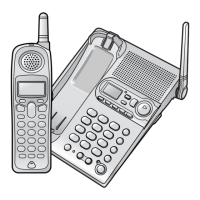


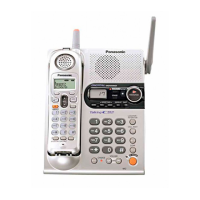

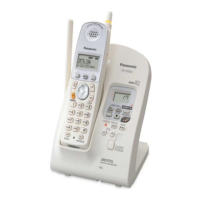
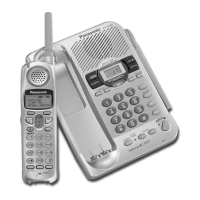
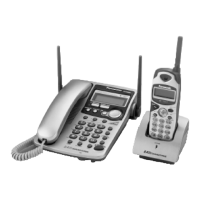

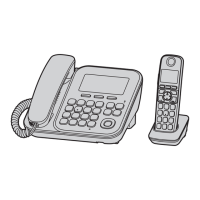

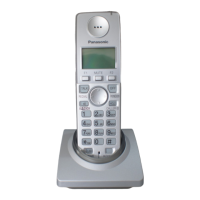
